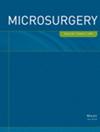Efficacy of Immediate Lymphatic Reconstruction in Prevention of Breast Cancer-Related Lymphedema: A Systematic Review and Meta-Analysis
Abstract
Background
Immediate lymphatic reconstruction (ILR) is a technique in which lymphatics are visualized and lymphovenous bypass is done at the time of axillary lymph node dissection (ALND) to prevent breast cancer-related lymphedema (BCRL). This meta-analysis estimates the benefit of ILR in preventing lymphedema by incorporating double- and single-arm studies and stratifying by length of follow-up time.
Methods
Three databases were queried for studies with primary data on ILR. Both double- and single-armed studies were included, and papers with small sample sizes, overlapping samples, and unreported data were excluded. Treatment effects were calculated with risk ratios and converted to a logarithmic scale. A meta-analysis was performed using the inverse variance method and a random-effects model, with further analysis done by study design and length of follow-up time.
Results
A total of 17 studies were included (9 double-arm and 8 single-arm; n = 2607). The pooled treatment effect of ILR, expressed as log risk ratio (95% CI), was −0.89 (−1.18, −0.60; p < 0.0001). This corresponds to a relative risk of 0.41 (0.31, 0.55) and a number needed to treat of 9. Double- and single-arm studies showed no significant differences in effect sizes. Studies with < 1-year follow-up demonstrated a larger effect size than those with longer follow-up, and the benefits of ILR were no longer significant past 3 years.
Conclusion
Patients receiving ILR were significantly less likely to develop BCRL than those receiving ALND alone. Further work is needed to examine whether benefits can truly be sustained long-term.


 求助内容:
求助内容: 应助结果提醒方式:
应助结果提醒方式:


